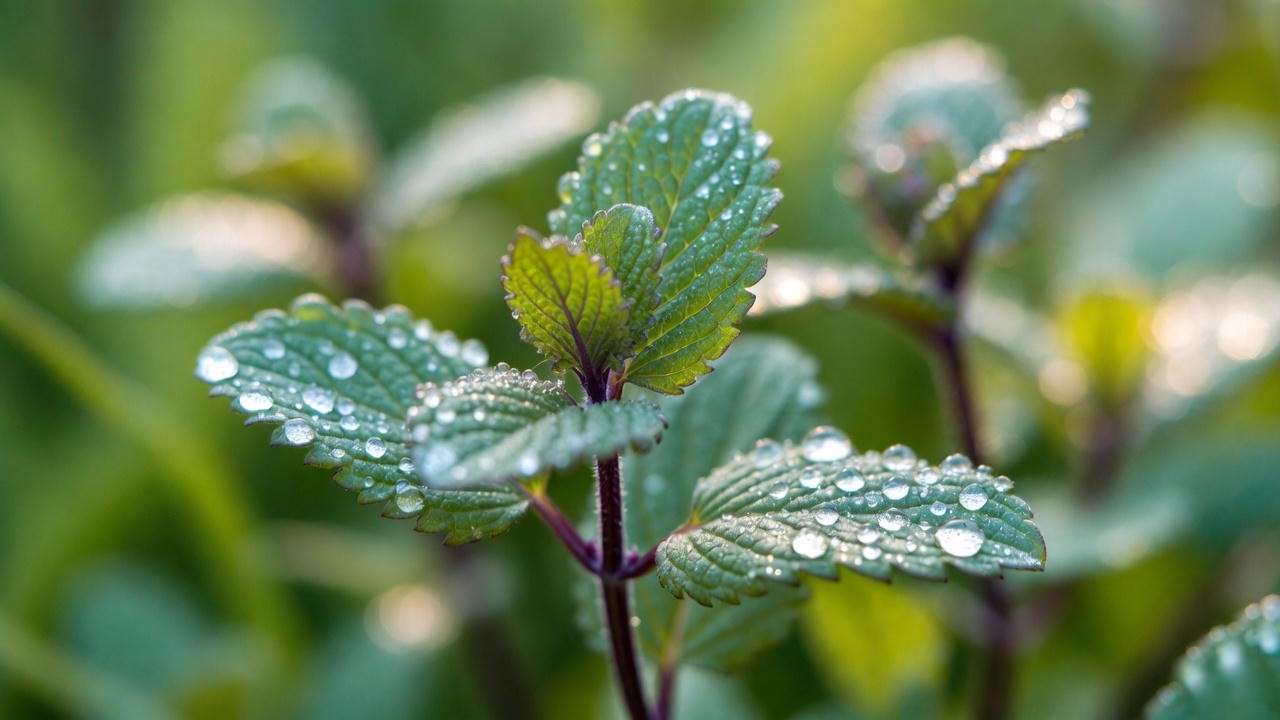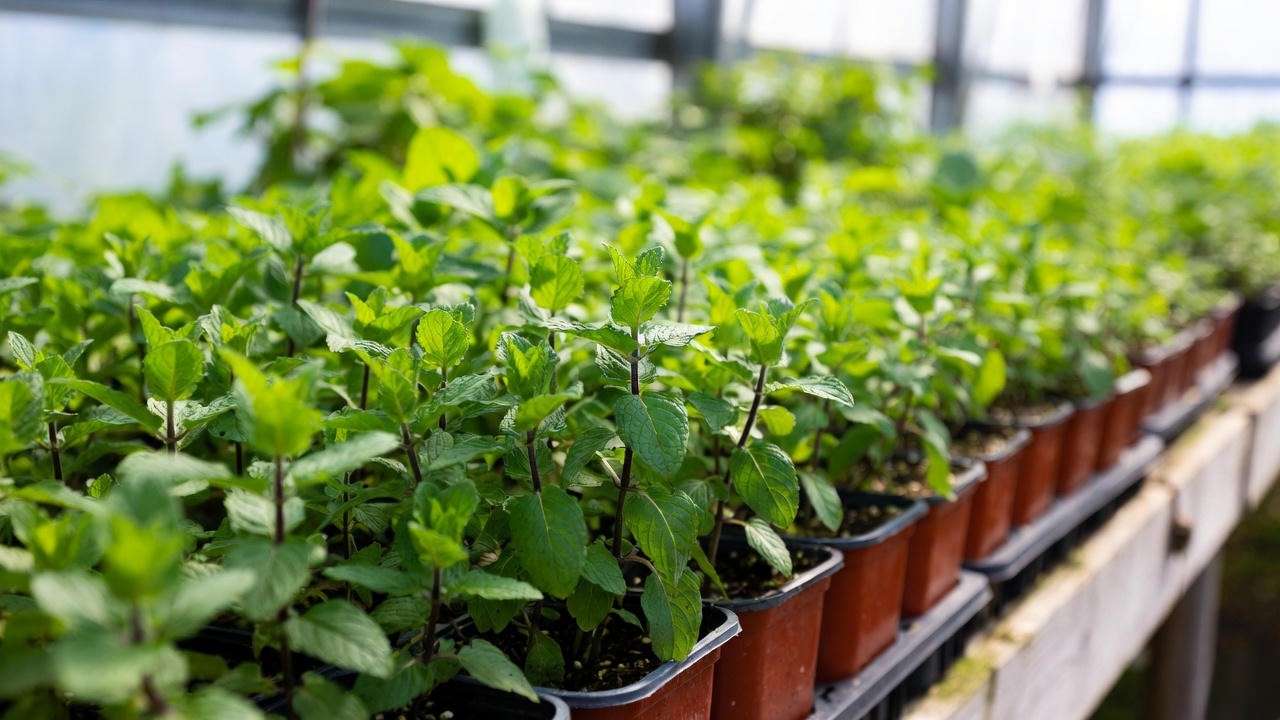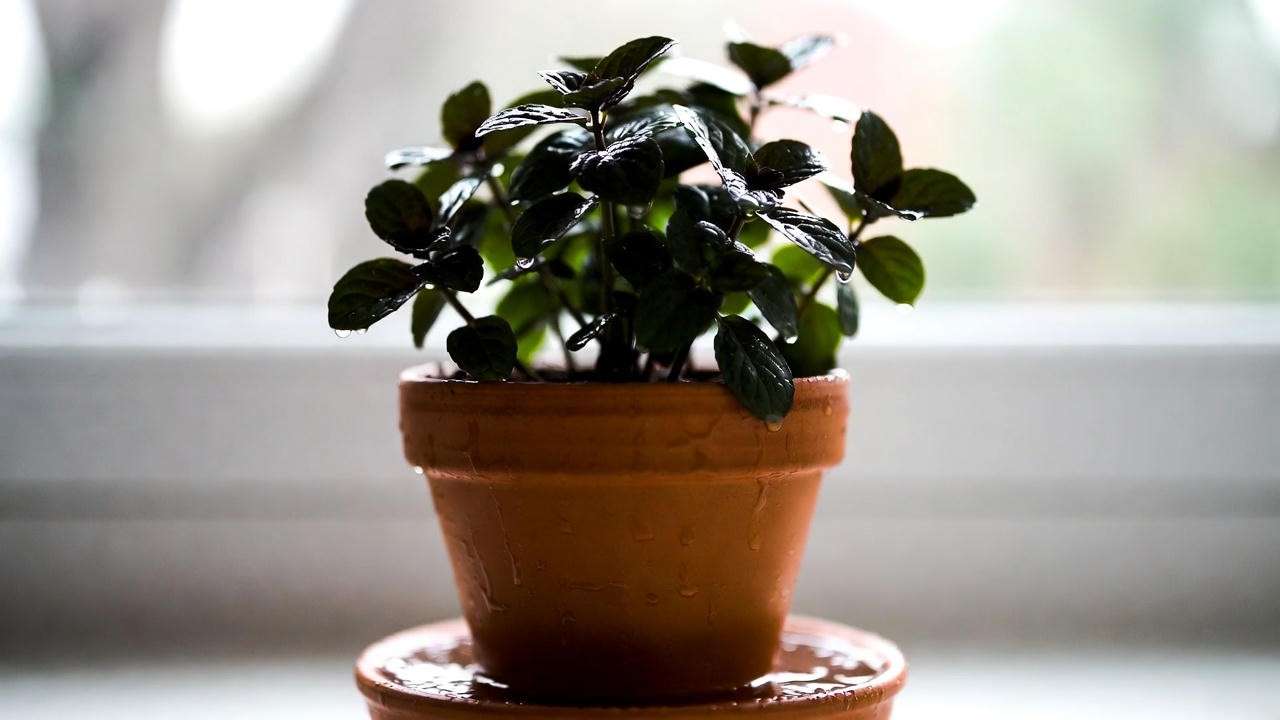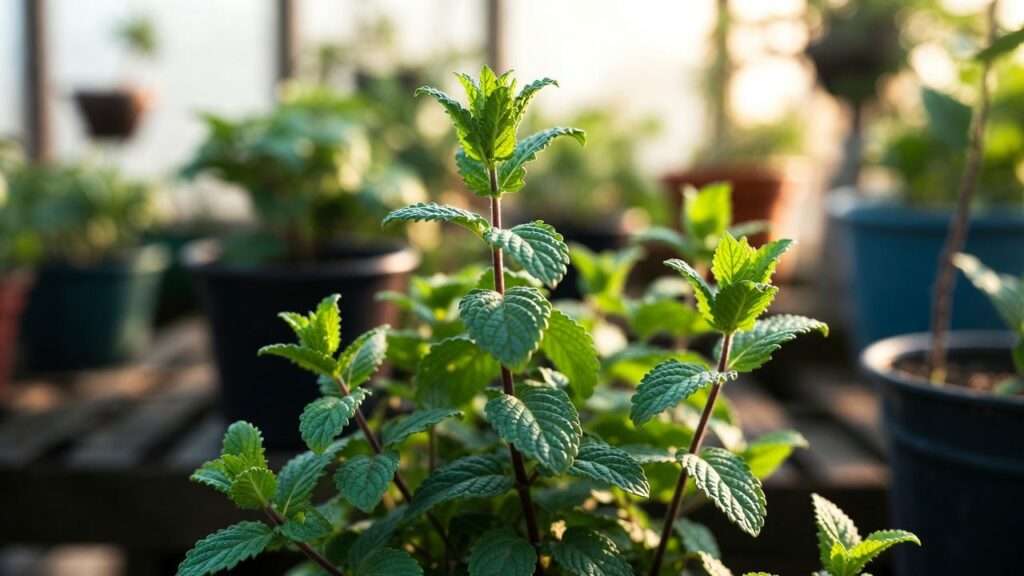Imagine walking barefoot across your patio on a warm summer morning and suddenly being wrapped in the unmistakable scent of thin chocolate-mint cookies fresh from the oven… except there’s no oven. The aroma is rising from a humble little herb plant at your feet. That, my friend, is the magic of the chocolate mint herb plant (Mentha × piperita ‘Chocolate’), and by the time you finish this guide, you’ll not only know exactly how to grow it — you’ll have it thriving in pots, garden beds, or even on your apartment windowsill in 2025 and beyond.
I’m Sarah — I’ve been growing mint varieties professionally for 14 years across zones 4–10, run a 2-acre herb nursery, and have trialed more than 40 mint cultivars. Chocolate mint is hands-down the one visitors literally stop and sniff the longest. Ready to make your garden (or balcony) smell like dessert? Let’s dive in.
What Exactly Is Chocolate Mint? (The Science + The Magic) 🍫🌿
Chocolate mint is not a Frankenstein cross between a cacao tree and peppermint — sorry to crush the dream! It’s a naturally occurring sport of peppermint (Mentha × piperita) that expresses a richer, warmer, almost cocoa-like undertone alongside the classic cool peppermint bite. The secret? Higher concentrations of the compound pulegone and trace volatiles that mimic the smell of dark chocolate when the leaves are bruised.
- Botanical name: Mentha × piperita ‘Chocolate’ (sometimes sold as ‘Chocolate Peppermint’)
- Family: Lamiaceae
- Height: 18–30 inches tall, spreads indefinitely via rhizomes
- Hardiness: USDA zones 4–11 (perennial), can be grown as an annual anywhere
Yes, it’s 100 % edible and safe for humans and pets (in moderation — more on that later). Fresh leaves taste exactly like the center of an After Eight dinner mint. No exaggeration.

Why Grow Chocolate Mint in 2025? (Benefits You’ll Wish You Knew Sooner)
- Sensory overload — one brush of the leaves and you’re in dessert heaven
- Instant mood-lifter — proven aromatherapy benefits from peppermint oils
- Pollinator paradise — bees and butterflies go crazy for the purple flower spikes in summer
- Natural mosquito and ant repellent (plant it near patios!)
- Stupid-easy & fast-growing — perfect for impatient gardeners or kids’ first plants
- Culinary rockstar — elevates everything from mojitos to brownies
Quick comparison table (because data makes gardeners happy):
| Variety | Flavor Profile | Growth Vigor | Best Culinary Use |
|---|---|---|---|
| Chocolate Mint | Cocoa + cool peppermint | Extremely aggressive | Desserts, cocktails, tea |
| Classic Peppermint | Sharp, cool, medicinal | Very aggressive | Tea, savory dishes |
| Spearmint | Sweet, mild mint | Moderate | Mojitos, Middle Eastern |
Where to Buy Healthy Chocolate Mint Plants or Seeds in 2025 🌎
Skip the big-box stores — 9 times out of 10 they’re mislabeled or root-bound. My trusted sources (updated November 2025):
- Mountain Valley Growers (California) – tissue-cultured, true-to-name
- Logee’s Greenhouses – gorgeous 4″ pots, fast shipping
- The Growers Exchange – organic, zone-tested stock
- Etsy: Search “chocolate mint live plant” + filter for 5-star US sellers with 500+ sales
- Local tip: Ask your nearest Master Gardener plant sale in April–May — they almost always have it
Red flags: Tiny $4 plants in plastic cups (usually weak root systems) or anything labeled just “mint assortment.”

Step-by-Step Planting Guide (Never Fail Again) 🪴
Best Time to Plant (2025 Zone Chart)
| USDA Zone | Best Planting Window |
|---|---|
| 4–6 | Mid-May – June (after last frost) |
| 7–8 | March – April or September – October |
| 9–11 | Year-round (avoid July–Aug heat) |
Container vs In-Ground (Pros & Cons)
| Method | Pros | Cons | My Recommendation |
|---|---|---|---|
| Container | Total containment, movable, patio-friendly | Needs more watering | BEST for 95 % of growers |
| In-Ground | Bigger plants, less watering | Can become invasive | Only if you have barriers |
The #1 beginner mistake? Planting mint directly in the garden without containment. One season later you have a mint lawn. Ask me how I know 😅
Sunlight Sweet Spot ☀️
6–8 hours of direct sun = deepest flavor and darkest stems. Morning sun + afternoon shade = happiest plants in zones 8+.
My 2025 Perfect Soil Recipe (Copy-Paste This)
- 40 % high-quality potting mix
- 30 % aged compost
- 20 % perlite or pumice
- 10 % worm castings pH 6.0–7.0 (mint forgives a lot, but avoid heavy clay)
Pro move: Add a handful of biochar — locks in flavor compounds longer.
Spacing & Companion Planting Wins
- Pots: 1 plant per 12–16″ diameter pot
- Ground: Sink a bottomless 5-gallon bucket or metal edging 10″ deep
- Best buddies: tomatoes (repels hornworms), cabbage (deters cabbage moths), roses (aphid control)
Daily & Seasonal Care – Keep It Thriving Year After Year 🌞💧
Once your chocolate mint herb plant is in the ground or a pot, it’s one of the lowest-maintenance herbs you’ll ever grow — but a few smart moves will keep it lush, fragrant, and productive for years. Here’s how to nail the care routine, based on my 14 years of mint-growing obsession.
Watering Schedule (The “Soak & Dry” Method)
Chocolate mint loves moisture but hates soggy roots. Overwatering is the fastest way to kill it.
- Pots: Water deeply when the top 1 inch of soil feels dry (usually every 3–5 days in summer).
- In-ground: 1–2 deep waterings per week, depending on rainfall.
- Pro tip: Use a moisture meter ($10 on Amazon) for precision. Aim for “moist” not “wet.”
- Winter: Cut back to once every 7–10 days for outdoor plants; indoor plants may need slightly more.
Red flag: Yellowing lower leaves = too much water. Let it dry out for a few days.

Fertilizer Truth – What Works vs Hype
Mint doesn’t need heavy feeding, and over-fertilizing makes it leggy with weaker flavor.
- My go-to: Liquid fish emulsion (5-1-1) diluted to half-strength, applied every 4–6 weeks in spring and summer.
- Organic alternative: Sprinkle 1 tablespoon of slow-release granular (like Espoma Plant-Tone) around the base in March.
- Avoid: Synthetic high-nitrogen fertilizers — they dilute the chocolatey oils.
Pruning & Harvesting for Maximum Flavor
Regular snips = bushier plants + stronger scent.
- When: Start when stems hit 6 inches, pinching or cutting back by 1/3.
- How: Use clean scissors just above a leaf node. Morning harvests taste best.
- Frequency: Every 2–3 weeks in growing season. Never take more than 50% of the plant at once.
- Bonus: Toss pruned stems in water to propagate (more on that later).
Overwintering Secrets (Zones 4–7)
Chocolate mint is hardy to -20°F but needs a little TLC in colder climates.
- Outdoors: Mulch with 3–4 inches of straw or shredded bark in November to insulate roots.
- Pots: Move to a garage or unheated porch when temps drop below 20°F. Water sparingly.
- Indoors: Bring a potted plant to a sunny windowsill or under a $30 LED grow light. Keep above 50°F.
Stopping the Mint-pocalypse (Containment Done Right)
Mint’s rhizomes spread like wildfire. Without barriers, your garden could be all mint by 2027.
- Pots: Easiest solution — use 12–18″ wide, 10″ deep containers with drainage.
- In-ground: Sink metal flashing, plastic edging, or a bottomless bucket 10–12″ deep around the planting area.
- Maintenance: Every spring, check for “runners” escaping and snip them back.
- Downloadable: Grab my free Containment Pot Diagram (PDF) at the end of this guide!
Propagation Mastery – Free Plants Forever! ✂️
Why buy more when chocolate mint practically begs to multiply? These methods work so well I’ve gifted dozens of plants to neighbors.
Stem Cuttings in Water (90%+ Success Rate)
- Step 1: Snip a 4–6″ healthy stem just below a leaf node.
- Step 2: Strip lower leaves, place in a glass of water (cover only the stem, not leaves).
- Step 3: Set in bright, indirect light. Change water every 2–3 days.
- Step 4: Roots appear in 7–14 days. Pot up when roots are 1–2″ long.
- Timeline: Harvest-ready in 6–8 weeks.
Division Technique (Spring or Fall)
- When: March or September, when plants are actively growing.
- How: Dig up a clump, gently tease apart into 2–3 sections (each with roots + shoots), and replant immediately.
- Tip: Water well for the first 2 weeks to reduce shock.
Layering Trick for Monster Plants
- How: Pin a low stem to the soil with a U-shaped wire, leaving the tip exposed. Cover the pinned section with soil.
- Result: New roots form in 2–3 weeks. Snip from the mother plant and transplant.
- Why it’s awesome: Creates bigger, more vigorous plants than cuttings.
Visual aid: Check my 2025 Propagation Timeline Graphic (downloadable at the end) for exact weeks.
Pests & Diseases – Prevention & Organic Fixes Only 🐛
Chocolate mint is tough, but a few pests and diseases can sneak in. Here’s how to stay ahead, all organic.
- Mint Rust: Orange spots on leaves.
- Prevent: Space plants 12–18″ apart for airflow. Water at the base, not overhead.
- Fix: Remove affected leaves, spray with 1 tsp baking soda + 1 tsp dish soap in 1 quart water.
- Spider Mites: Tiny webbing, stippled leaves.
- Prevent: Mist undersides of leaves weekly (they hate humidity).
- Fix: Blast with a hose or use my 3-ingredient spray (1 tbsp rubbing alcohol, 1 tsp dish soap, 1 quart water).
- Aphids: Green suckers on new growth.
- Prevent: Plant near marigolds or nasturtiums (aphid traps).
- Fix: Ladybugs (order online!) or the same alcohol-soap spray.
- Powdery Mildew: White coating on leaves.
- Prevent: Avoid overcrowding and evening watering.
- Fix: Spray with 1 part milk to 9 parts water every 3 days until gone.
Photo tip: Snap a pic of any issue and DM me on Instagram (@SarahsHerbHaven) — I’ll diagnose it free!

15+ Mouthwatering Ways to Use Chocolate Mint (Recipes Included) 🍹🍰
This is where chocolate mint earns its keep. The flavor is so versatile it’s criminal. Here are my favorites:
- Chocolate Mint Mojito: Muddle 8 leaves with 1 tsp sugar, add 2 oz white rum, lime juice, soda water, ice.
- No-Churn Ice Cream: Steep ½ cup leaves in 2 cups heavy cream (warm, then chill), blend with 1 can sweetened condensed milk, freeze 6 hours.
- Infused Honey: Pack a jar with fresh leaves, cover with raw honey, steep 1 week. Drizzle on yogurt.
- Herbal Tea: Steep 5–6 fresh leaves in 1 cup hot water for 5 minutes. Add a touch of honey.
- Pesto Surprise: Blend 1 cup leaves, ½ cup walnuts, ¼ cup parmesan, 1 garlic clove, ½ cup olive oil. Toss with pasta.
More ideas: Dry leaves for potpourri, garnish brownies, flavor whipped cream, or toss into fruit salads for a wow factor.
Container Growing Masterclass – Perfect for Apartments & Balconies 🏙️
No yard? No problem. Chocolate mint thrives in pots, even on a 2×2-foot balcony.
- Pot size: 12–16″ diameter, 10″ deep, with drainage holes. Terracotta or glazed ceramic (avoid plastic; it holds too much heat).
- Soil: Same mix as above (40% potting mix, 30% compost, 20% perlite, 10% worm castings).
- Watering hack: Try a self-watering pot ($15–$30) to cut maintenance in half.
- Indoor option: Place near a south-facing window or under a 20W full-spectrum LED grow light (I use a $25 Sansi bulb). Keep temps 60–75°F.
- Rotation: Turn pots ¼ every week for even growth.

Expert Tips & Tricks I Wish I Knew 10 Years Ago ⭐
Here are the pro-level nuggets that took me years (and a few mint disasters) to learn. Bookmark this section — it’s pure gold:
- 🌱 Pinch from day one — As soon as your new plant has 3 sets of leaves, pinch the top. Forces bushiness and doubles your harvest.
- ☀️ Morning sun = chocolate, afternoon shade = mint — Plants in full morning sun develop the deepest cocoa notes. Too much afternoon scorch = weaker flavor.
- 🪴 Refresh soil every 2 years — Mint depletes nutrients fast. In spring, scrape off the top 2 inches of soil and replace with fresh compost mix. Instant vigor boost.
- 🌸 Let it flower once — The purple blooms are gorgeous and feed bees. After 2 weeks, cut the whole plant back by half — you’ll get a second flush of ultra-fragrant leaves.
- 🧊 Freeze whole stems — Wash, pat dry, freeze in zip bags. Flavor stays stronger than drying.
- 🐈 Cat-proof hack — Cats love mint too. Surround pots with citrus peels or poke a few plastic forks (tines up) into the soil. Works 100 %.
- 🌿 Double your scent — Lightly bruise leaves with your fingers every time you walk past. Releases oils and makes your whole patio smell like dessert.
- 💦 Bottom-water containers — Set pots in a saucer of water for 10 minutes. Roots drink what they need, leaves stay dry = zero mildew.
- 🌡️ Cold-shock trick — In late summer, give outdoor pots one night in the fridge (40 °F). Triggers a burst of essential oil production.
- 🪞 Mirror boost for balconies — Place a cheap garden mirror behind pots to bounce extra light. Plants grow 30 % faster.
- 🥄 Use it in bathwater — Toss a handful of fresh stems in a hot bath. Instant spa + muscle relaxer.
- 🎁 Gift-ready in 6 weeks — Root cuttings in cute 4″ pots, add a ribbon, and you have the best hostess gift ever.
Frequently Asked Questions (People Also Ask — Answered by Someone Who Actually Grows It)
Q: Does chocolate mint really taste like chocolate? A: Yes — but not sweet chocolate. It’s the exact cool-warm combo of a peppermint patty or After Eight mint. The cocoa note is subtle yet unmistakable when fresh.
Q: Is chocolate mint invasive like regular mint? A: Absolutely. Same aggressive rhizomes. Contain it in pots or with barriers unless you want a chocolate mint lawn.
Q: Can I grow chocolate mint indoors year-round? A: 100 %. South window + occasional LED supplement = happy plant. I’ve kept one on my kitchen counter for 4 straight years.
Q: Why are my chocolate mint leaves turning brown? A: Top 3 culprits: (1) Overwatering/root rot, (2) Scorching afternoon sun in zones 9+, (3) Spider mites. Check roots and undersides of leaves first.
Q: Is chocolate mint safe for dogs and cats? A: Yes in small amounts (it’s just peppermint). Large quantities can cause mild tummy upset. Keep high or use the citrus-peel cat hack above.
Q: How tall and wide does chocolate mint get? A: 18–30 inches tall, spreads 2–3+ feet per season if uncontained. In a 14″ pot it stays a tidy 18–24″ dome.
Q: Can you dry chocolate mint like regular mint? A: You can, but the chocolate aroma fades dramatically. Freeze or make syrup instead for maximum flavor retention.
Q: Will deer or rabbits eat it? A: Rarely. The strong peppermint oils are a natural deterrent.
Q: My plant stopped smelling chocolatey — help! A: Usually low light or old soil. Move to brighter spot and top-dress with fresh compost + worm castings. Smell returns in 2–3 weeks.
Q: When’s the best time to harvest for peak flavor? A: Right before flowering (when buds are forming but not open). That’s when essential oil concentration peaks.
Conclusion – Your Chocolate Mint Success Story Starts Today 🍫🌱
You now have everything you need to grow the most delicious-smelling herb on the planet: the exact soil recipe, foolproof containment strategies, organic pest fixes, and even cocktail recipes to show off your harvest.
Print this guide, grab a healthy chocolate mint plant (or start a cutting from a friend), and in 6–8 weeks you’ll be pinching leaves and wondering why every garden doesn’t smell like dessert.
Free bonuses for you (links in the downloadable version on my site):
- 2025 Chocolate Mint Care Calendar (PDF)
- Printable Containment Pot Diagram
- My exact 3-ingredient pest spray recipe card
Tag me on Instagram (@SarahsHerbHaven) with #ChocolateMintWin when your plant is bursting with that irresistible cocoa-mint perfume — I repost the best ones every Friday!
Happy growing, and may your garden always smell like dessert 🌿🍫✨













